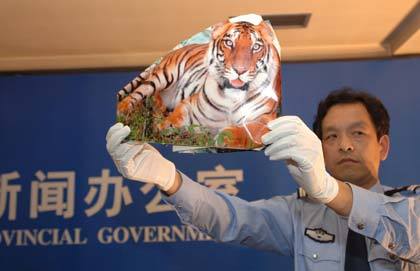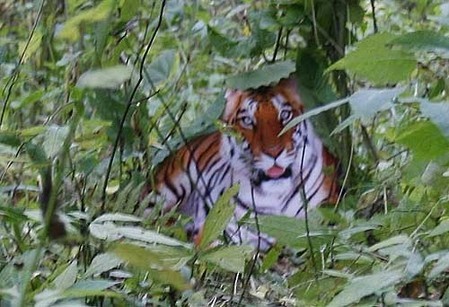The controversial south China tiger photographs by farmer Zhou Zhenglong were proved fake, according to sources at a press conference of the Shaanxi Provincial government on Sunday.
 A policeman displays a photograph of the endangered South China tiger "shot" by farmer Zhou Zhenglong during a press conference announcing the result of an investigation into the photograph after it was proved fake in Xi'an, capital of Northwest China's Shaanxi Province June 29, 2008.
A policeman displays a photograph of the endangered South China tiger "shot" by farmer Zhou Zhenglong during a press conference announcing the result of an investigation into the photograph after it was proved fake in Xi'an, capital of Northwest China's Shaanxi Province June 29, 2008.
Zhou, a 53-year-old from the Zhenping county of Shaanxi who claimed to have photographed the tiger with a digital camera on the afternoon of Oct. 3 last year, was suspected of swindle and arrested. His reward, 20,000 yuan (US$2,915) by the Provincial Forestry Department, was revoked.
Police have seized an old tiger picture, which he borrowed from a farmer of another village last September to produce his photos. They also found a wooden model of tiger claw, which Zhou used to shoot his photo of south China tiger's footprint on snow.
Thirteen local official in connection with the scandal were punished, including deputy head of the Provincial Forestry Department Zhu Julong and Sun Chengqian, the official in charge of wildlife preservation Wang Wanyun, as well as media official Guan Ke who were dismissed from their posts.
Li Qian, an official with the wildlife preservation station of the Zhenping county, was also sacked as he did no on-the-spot check before faking a verification report for the photos.
Zhou's tiger photos, first published on Oct. 12, had been used by the Provincial Forestry Department as proof that the rare tiger still existed in the wild at a press conference.
But Internet users accused Zhou of making the tiger images with digital software, and local authorities of approving the photos to bolster tourism.
The "paper tiger" saga aroused widespread interest among the public following the appearance of a Lunar New Year commemorative poster whose image of a tiger bore a striking resemblance to the one in Zhou's pictures. Official proof of authenticity was thus strongly demanded.
The embarrassed provincial forestry department apologized to the public in a letter for "curtly publicizing the discovery of the wild South China tiger" in February, but made no comment on the publication's authenticity.
The South China tiger, also called the "Amoy" or "Xiamen tiger, " is widely believed to be extinct in the wild. It is thought to be the ancestor of all tigers, according to the World Wildlife Fund.
The tiger is considered critically endangered, mainly due to a loss of habitat. By 1996, the tigers numbered only 30 to 80, according to the World Conservation Union's Red List of threatened species.
 A purported South China tiger is pictured in this file photo taken by farmer Zhou Zhenglong.
A purported South China tiger is pictured in this file photo taken by farmer Zhou Zhenglong.
(Xinhua News Agency June 29, 2008)